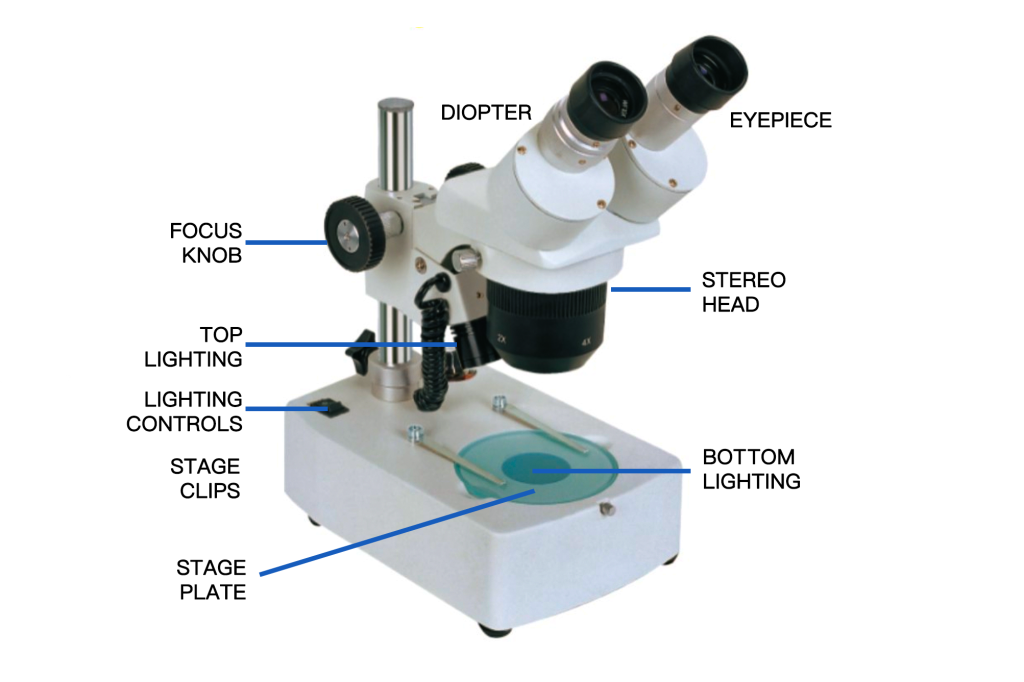I. What is a Stereomicroscope?
A stereo microscope is an optical microscope that provides a three-dimensional view of specimens. It’s also known by other names such as dissecting and stereo zoom microscopes. Components of a dissecting microscope include separate objective and eyepieces, hence each eye has its independent optical path. The slight angle difference between the left and right eyes creates a three-dimensional visual effect. Due to its provision of a three-dimensional view, it’s also termed a dissecting microscope.
II. Characteristics of Stereomicroscopes:
- Two distinct objectives
- Two separate optical paths
- Utilizes light reflected from the object
- Typical magnification range from 10x to 50x
- Three-dimensional imaging
III. Components of Stereo Microscopes:
The components of a stereomicroscope serve specific functions. These components may vary significantly depending on their configuration and intended use. The various parts of a stereomicroscope include:

- Stereo Head: This is the movable top part of the microscope, housing two adjustable eyepieces.
- Eyepieces: Through these eyepieces, observers view the specimen. Eyepieces are typically set to a magnification of 10x but can be upgraded to higher magnification levels.
- Diopter Adjustment: Compensates for focusing differences between the left and right eyes, preventing eye fatigue.
- Objectives: Stereomicroscopes have two independent objectives, each connected to one eyepiece. Eyepieces and objectives together determine the microscope’s magnification.
- Focus Knob: Stereomicroscopes typically feature a focus knob to help move the microscope head up and down for a clear image of the object.
- Stage Clip: Assists in securing slides or other thin objects on the stage.
- Stage Plate: This is located directly beneath the objectives, where specimens are placed for viewing.
- Illumination: Many microscopes have top and bottom illumination. Some have only one illumination source—either top or bottom.
IV. How Stereomicroscopes Work:
Stereo Microscopes or dissecting microscopes utilize reflected light from the object. They offer low-power magnification, making them ideal for magnifying opaque objects. Since they use light naturally reflected by the sample, they’re helpful for examining solid or thick samples. The magnification range of stereomicroscopes typically falls between 10x and 50x.
Additional/auxiliary lenses can be attached to increase or decrease magnification and adjust working distance as per user requirements. Stereomicroscopes allow for the observation of objects like coins, fossils, mineral specimens, insects, flowers, etc.
V. Differences Between Stereomicroscopes and Biological Microscopes:
Stereomicroscopes and biological microscopes differ significantly in five aspects:
1. Different uses:
Stereomicroscopes are widely used in industrial fields such as material surface observation, failure analysis, fracture analysis, etc.
Biological microscopes are used in medical institutions, higher education institutions, research institutes for observing microorganisms, cells, bacteria, tissue cultures, suspensions, precipitates, etc.
2. Different working distances:
Stereomicroscopes have a larger working distance, typically ranging from 50mm to even 150mm; whereas the working distance for observing objects with a biological microscope rarely exceeds 20mm.
3. Different Placement of Objects:
Stereomicroscopes can accommodate taller, thicker objects such as large workpieces, screws, thicker objects, etc., while biological microscopes can only accommodate thin slices, slides, etc.
4. Difference in Depth of Field Range:
Stereomicroscopes have a larger depth of field range, reaching up to 10mm, providing a considerably wide range of clear imaging by adjusting the focus ring; whereas with biological microscopes, slight adjustments to the focus ring may blur the image.
5. Different Adaptability Ranges:
Stereomicroscopes offer a stereoscopic image due to their wide depth of field. However, they have smaller magnification, typically achieving around 200x; whereas biological microscopes generally achieve magnifications of around 2000x, with characteristics parameters opposite to stereomicroscopes.
VI. Primary Uses of Stereomicroscopes:
Stereomicroscopes are easy to operate and have a wide range of applications, including:
- Research in zoology, botany, entomology, histology, mineralogy, archaeology, geology, and dermatology.
- In the textile industry, for inspecting raw materials and cotton wool fabrics.
- In the electronics industry, for operations such as transistor spot welding and inspection.
- Inspection of surface phenomena such as crack composition in various materials, pore shapes, corrosion conditions, etc.
- In the manufacture of small precision parts, for observing machine tool devices, observing the working process, inspecting precision parts, and assembling tools.
- Inspection of surface quality of lenses, prisms, or other transparent substances, as well as the quality of precision scales.
- Determination of the authenticity of coins and banknotes.
- Widely used in various fields including textile products, chemical industry, plastic products, electronic manufacturing, mechanical manufacturing, pharmaceutical manufacturing, food processing, printing industry, higher education institutions, and archaeological research.